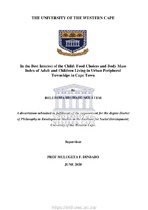| dc.description.abstract | The increase in overweight and obesity worldwide is described as a global health epidemic. A great proportion of this epidemic is now found in low- and middle-income countries with higher levels of prevalence, particularly in emerging economies. In sub-Saharan Africa, South Africa ranks high in the prevalence of obesity at all levels. Since the inception of democracy in 1994, the government is yet to overcome the burden of poverty and inequality routed in its apartheid past. Apartheid systematically and unjustly disintegrated and segregated black Africans and people of Colour, denying them access to economic opportunity, thus leaving them on a dependency status. Khayelitsha and Mitchells Plain are the relics of apartheid policies. Obesity and associated diseases are highly correlated with gender dynamics, economic conditions, nutritional status, poverty, and urbanisation. It is increasingly evident that poor urban dwellers, especially women and children are at risk of obesity-related factors such as diabetes, hypertension, and heart diseases. The increasing incidence of obesity especially amongst children is concerning. The prevalence of child poverty is in South Africa is a cause for concern. Over 18.5million children are in South Africa, 64% of which are dependent on CSG. With poverty and inequality affecting millions of households, access to food and quality food has reached crises level. Yet, it is a basic human right that has received little empirical response amongst policymaker in South Africa. The South African food system is complex, poverty is endemic and poor households are most vulnerable to unhealthy eating habits. This research critically analysis the link between food choices, overweight and obesity in adults and children living in urban peripheral communities in Cape Town. The study was designed to interrogate the kinds of food eaten by urban peripheral dwellers, their socioeconomic status and how the policy of the BIC addresses the problem of child obesity in South Africa. This research aimed to empirically explore the relationship between BMI and food choices of adults and children living in urban peripheries in Cape Town. The study also aimed at evaluating the BIC in urban townships in Cape Town in the context of child obesity, to understand the views of the children and to understand how poor households are ensuring the BIC in relation food access, food availability and child protection from obesity. The study further aimed at comparing the and contrasting the socioeconomic dynamics of the two population to understand the progress and gaps in their economic and health status. Empirical data were collected from households in Khayelitsha and Mitchells Plain using a two-stage sampling technic to identify clusters and households. A sample of about 4300 individuals in 1052 households was sampled. A 24H dietary recall was used to capture food types of the population. The World Health Organisation guidelines for BMI adults and children were applied through the study. A BIC Index was developed to assess the right to food from the views of the child. First, the study found significant differences in the socioeconomic and demographic profiles of the population. Poverty and the risk of falling into poverty were higher in Khayelitsha than in Mitchells Plain. Two-third of the population (65%) of adults we found to be overweight and obese. Overweight and obesity amongst children was 29% and 68% of children reported that they buy food at school or on their way to school. Over 83% children stated that their parents give them money to take to school. There was a significant association between children buying food and parents giving money at X2 91.4643, P<= 0.000. Carbohydrate represents 40% and sugar 35% of food types children eat away from home. In terms of the BIC, 43% of the children | en_US |

